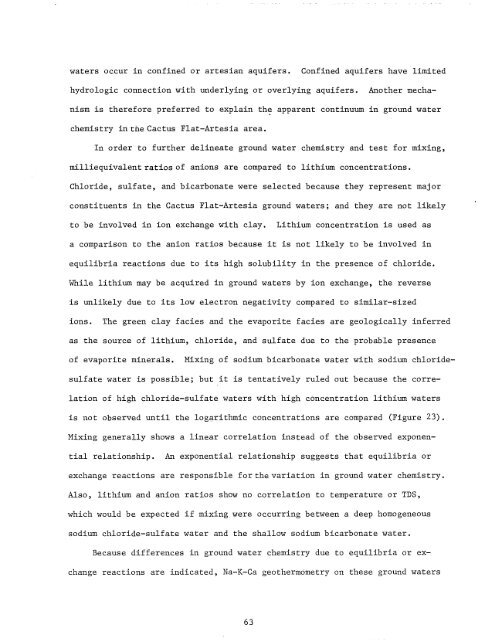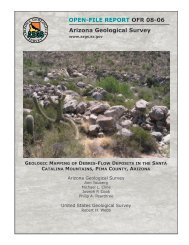geothermal resource potential of the safford-san simon basin, arizona
geothermal resource potential of the safford-san simon basin, arizona
geothermal resource potential of the safford-san simon basin, arizona
Create successful ePaper yourself
Turn your PDF publications into a flip-book with our unique Google optimized e-Paper software.
waters occur in confined or artesian aquifers.<br />
Confined aquifers have limited<br />
hydrologic connection with underlying or overlying aquifers.<br />
Ano<strong>the</strong>r mechanism<br />
is <strong>the</strong>refore preferred to explain th~<br />
apparent continuum in ground water<br />
chemistry in <strong>the</strong> Cactus Flat-Artesia area.<br />
In order to fur<strong>the</strong>r delineate ground water chemistry and test for mixing,<br />
milliequivalent ratios <strong>of</strong> anions are compared to lithium concentrations.<br />
Chloride, sulfate, and bicarbonate were selected because <strong>the</strong>y represent major<br />
constituents in <strong>the</strong> Cactus Flat-Artesia ground waters; and <strong>the</strong>y are not likely<br />
to be involved in ion exchange with clay.<br />
Lithium concentration is used as<br />
a comparison to <strong>the</strong> anion ratios because it is not likely to be involved in<br />
equilibria reactions due to its high solubility in <strong>the</strong> presence <strong>of</strong> chloride.<br />
While lithium may be acquired in ground waters by ion exchange, <strong>the</strong> reverse<br />
is unlikely due to its low electron negativity compared to similar-sized<br />
ions.<br />
The green clay facies and <strong>the</strong> evaporite facies are geologically inferred<br />
as <strong>the</strong> source <strong>of</strong> lithium, chloride, and sulfate due to <strong>the</strong> probable presence<br />
<strong>of</strong> evaporite minerals.<br />
Mixing <strong>of</strong> sodium bicarbonate water with sodium chloridesulfate<br />
water is possible; but it is tentatively ruled out because <strong>the</strong> correlation<br />
<strong>of</strong> high chloride-sulfate waters with high concentration lithium waters<br />
is not observed until <strong>the</strong> logarithmic concentrations are compared (Figure 23).<br />
Mixing generally shows a linear correlation instead <strong>of</strong> <strong>the</strong> observed exponential<br />
relationship.<br />
An exponential relationship suggests that equilibria or<br />
exchange reactions are responsible for <strong>the</strong> variation in ground water chemistry.<br />
Also, lithium and anion ratios show no correlation to temperature or TDS,<br />
which would be expected if mixing were occurring between a deep homogeneous<br />
sodium chloride-sulfate water and <strong>the</strong> shallow sodium bicarbonate water.<br />
Because differences in ground water chemistry due to equilibria or exchange<br />
reactions are indicated, Na-K-Ca geo<strong>the</strong>rmometry on <strong>the</strong>se ground waters<br />
63

















